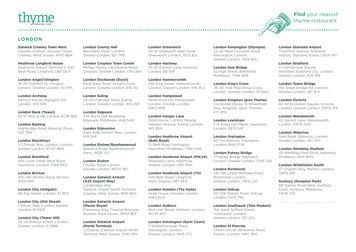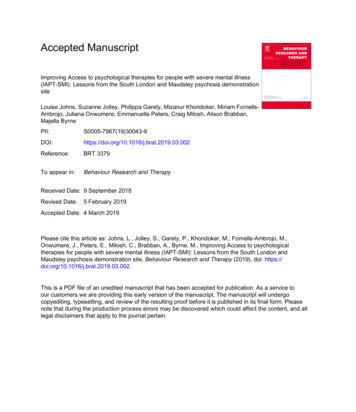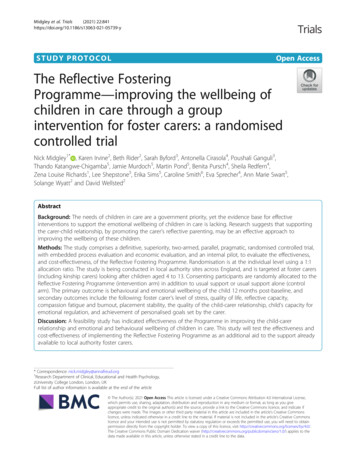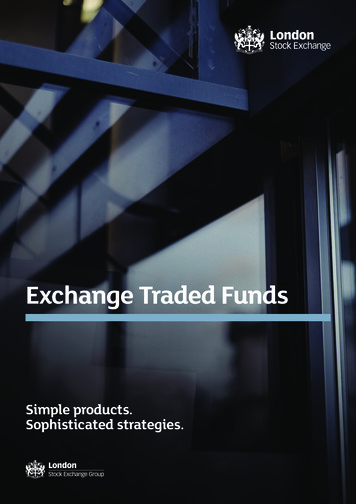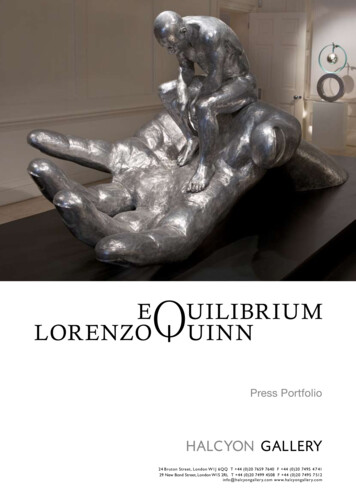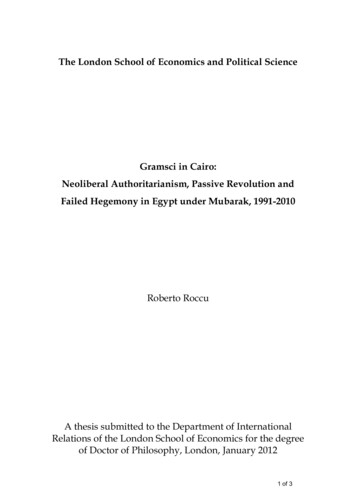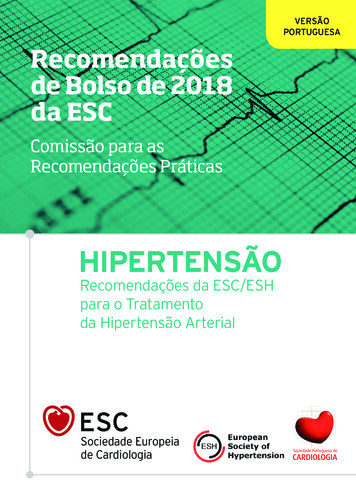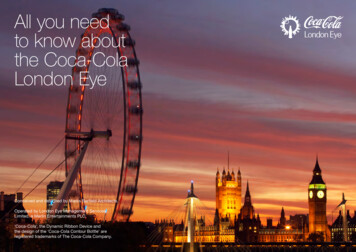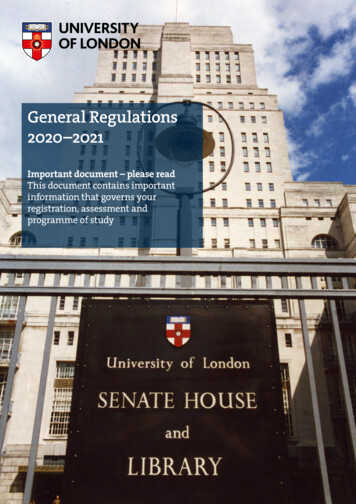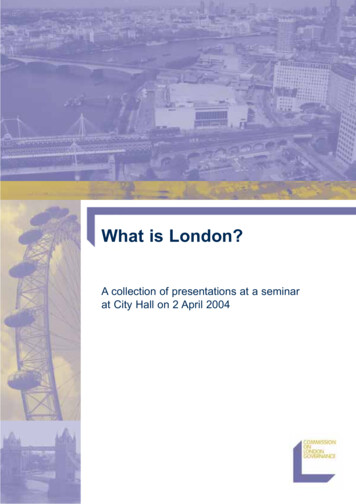
Transcription
What is London?A collection of presentations at a seminarat City Hall on 2 April 2004
What is London?A collection of presentations at a seminarat City Hall on 2 April 2004, organisedby the Commission on London Governance
copyrightCommission on London GovernanceOctober 2004Published byGreater London AuthorityCity HallThe Queen’s WalkLondon SE1 2AAwww.london.gov.ukenquiries 020 7983 5769minicom 020 7983 4458ISBN 1 85261 642 3Cover photographs Nicki Tucker / GLAThis document is printed on recycled paperAcknowledgementsAll the London maps are based on OS boundaries Crown Copyright, all rights reserved(GLA)(LA100032379)(2004)London’s Functional Urban Area is derived from a mapappearing in Les Cahiers No. 135, 4th quarter 2002;GEMACAData on residence of people working in London is from theLabour Force Survey 2001/02 and on house pricesfrom ODPM, both Crown Copyright
contentsspeakers2introduction3presentationsIain Sinclair - How the Thames has shaped London5Anthony Mayer - Where does London end?13Tony Travers - A tale of five capitals and two cities19Michael Heseltine - London tomorrow27Association of London Government/London Assembly 34
2 Commission on London GovernanceSpeakersIain SinclairAuthor of London Orbital, Iain Sinclair has gained a reputation as oneof the foremost writers on the capital. Born in Cardiff, he moved toHackney in the 1960s. Iain trained at the London School of FilmTechnique and first began publishing his own poetry in the 1970s,paying the bills by working as an odd jobs man and then as anoccasional book dealer. Iain’s books include Downriver; Landor’sTower; White Chappell, Scarlet Tracings; Lights out for the Territoryand Lud Heat.Anthony MayerThe former chief executive of the Housing Corporation took up thesame role at the Greater London Authority in October 2000. Hebegan his career in the Civil Service when he joined the Ministry ofHousing and Local Government in 1967, rising to become principalprivate secretary to the Secretary of State for Transport between1980 and 1982. He left the Civil Service in 1985 to join the merchantbankers N.M. Rothschild & Sons.Tony TraversThe pre-eminent academic on the capital, Tony Travers is Director ofthe Greater London Group, a research centre at the London Schoolof Economics. He is also Expenditure Advisor to the House of CommonsSelect Committee on Education and Skills, a Senior Associate at theKing’s Fund and a member of the Arts Council of England’s TouringPanel. Tony has just published The Politics of London: Governing anUngovernable City.Michael HeseltineAfter decades of public service, Lord Heseltine has emerged as thegodfather of regeneration. Lord Heseltine became closely associatedwith the regeneration of Liverpool after the riots of 1981. In 1979 hewas appointed Secretary of State for the Environment in MrsThatcher’s first government. Amongst his first initiatives were theestablishment of the Development Corporations in London andLiverpool. Many of the policy changes that remain at the heart ofgovernment regeneration policy first saw the light of day in Liverpoolfrom 1979. In 2008, Liverpool will be the Capital of Culture.
Commission on London Governance 3IntroductionAs Iain Sinclair, the Hackney-based author, recalled at City Hall lastApril, Ford Madox Ford once declared: ‘The future of London is verymuch in our hands’. Almost a century after those words were written,their sentiment is as resonant as ever. While the creation in 2000 ofthe Greater London Authority (GLA) restored Londonwide strategicgovernment, the need remains for wider debate about the structureand governance of public services both in the capital and throughoutthe country.To establish where reform might be needed and what shape it mighttake, the London Assembly and the Association of London Government(ALG) have come together to set up the Commission on LondonGovernance. The most significant review of its kind since the HerbertCommission in the 1960s and the Marshall Inquiry in the late 1970s,the joint project is inquiring into the best way that public services canbe delivered and made more answerable to voters. The aim is to feedideas into Government policy development.To push the reform of London’s governance further up the agenda,the commission hosted a seminar entitled What is London? at CityHall on 2 April 2004. First, Iain Sinclair spoke of the capital’s historyand how it shapes those who call themselves Londoners. NextAnthony Mayer used a series of slides to show the spread of Londonwell outside its administrative boundaries.Tony Travers then compared London’s governance with that of otherworld cities, pointing out that few are as financially dependent oncentral government as our own capital. Michael Heseltine was last,calling for the Mayor of London to have more power and greaterindependence from central government to push through projects,such as the Thames Gateway, upon which the capital’s futureprosperity depends.The speakers’ presentations are, for the first time, presented inthis booklet.
4 Commission on London Governance
Commission on London Governance 5How the Thames has shaped LondonIain SinclairI am not a scholar nor an academic. I do not have any constituency; Iam not a politician. I am just somebody who has bumbled aboutstrategically trying to survive in London since 1968 and who hasoccasionally written accounts of curious walks, such as the mostrecent one in which I decided to define what London actually was,and where it finished, by circumnavigating the M25 on foot.The most important thing for me, and I felt it again this morning walkinghere, is the very special light along this river. It is so persuasive. In aday's walking through London, the light changes all the time. Whenwe just have to shuffle between meetings or we only see the open airfor a brief period, we can have that darkness. However, if you areout there – if you take the opportunity to walk this river, which is themeaning, history and blood of London, then that light will change andshift all through the day. You can walk from the estuary in the rain,with clouds heavy and pressing down, and suddenly the clouds willpart and you will see shafts of sunlight.These epiphanies are the nature of London – its duality – and havebeen from the time the Romans were here establishing the religion ofMithras, the Mithraic religion which is schizophrenic and dualistic. It isdarkness and light. The whole sense of London is always that, the kindof darkness you find in the gothic novels of Peter Ackroyd or MichaelMoorcock, and the light you find in new writers like Zadie Smith, whoshow a multicultural city engaged and energised.There is always a sense of strategic reality, political reality; things cannotbe as the visionaries pitch them and would like them to be. The Templeof Mithras, which once stood alongside a now-vanished river comingdown through the city, has actually moved into the grounds of a HongKong bank. It was dug up and replaced, so it is not where it was. Itsmeaning is completely changed and perverted – the alignments are alldifferent and there are just a few rocks in the ground – but from theserocks can be traced the history and the blood of London. It is there. Itcomes in with the Romans, with the Vikings, and with wave afterwave of immigrants. The most important thing is that we must knowwhere we are before we can tell who we are.
6 Commission on London GovernanceWe must also be very careful to understand that London, aboveeverything else, is a city of language. It is now a city of many languages.Even the shapes of the buildings, the adverts on the walls, the signs,the scraps of paper you find in the gutter, all these things obsess me,and they are all forms of language – including graffiti. In an earlierbook called Lights Out for the Territory I did an enormous survey, agigantic ‘V’ that ran from Hackney down to Greenwich, where therewas an exhibition about language in the university, and back up theother side of the River Lea recording the cultural contour lines ofLondon in terms of the graffiti.Hackney has a fabulous anthology of graffiti from anarchists, Kurdishpolitical groups, Marxists, and just 'taggers' – often middle-class kids.The whole landscape was awash with these things, which peoplewould treat as eyesores and as a disgrace the city should dosomething about. On the other hand, it is a sign of diversity andenergy. As you moved into quieter, deader, more suburbanboroughs, of course the graffiti vanished but I actually – bizarrely –felt diminished because some of this language was going.In a place such as City Hall, I am very much aware that there areactually two forms of discourse and language that come into play.The normal one is the realpolitik, the political language of business,which most of you would be engaged with, and which I characteriseperversely as taking real evidence – documentation, facts, committeesand all the rest of it – and turning it into a final form which is not true,which is smoothed over and presented in the best possible light.The side I represent, the poetic, which I use in the broadest sense,takes in all kinds of artists, painters, writers and anybody who thinksabout the city. We all bend the evidence to start with. We tell lies, usefiction, exaggerate, satirise and do all of that to arrive at a truth.There is a naked truth or there is nothing for those writers. That sideof it is the argument I would like to put.That is how I see the river, in the way that the poets from AlexanderPope through to William Blake, Shakespeare to T.S. Eliot have beenobsessed; they have understood that the river itself is London. Out ofthe river comes London. Out of the sediment of the river comes London,and it gradually grows up.First of all, where we are is geology. It is geography. It is looking atHawksmoor churches and seeing in the white Portland stone thefossils. It is in looking at the paving stones, seeing the fossil record
Commission on London Governance 7there, that we see where the city came from – out of the sea. We seethe stones that are fish. We see the symbol of the fish in the Romancity. The city exists in this wonderful multiple time.Where are we now? What was here before? Back to language again.We are in this strange building called City Hall. It is not in the Cityand it is not a Hall. This is the kind of business I mean. What itactually means, saying City Hall, is that we would like to be in NewYork. It is a virtual city and a virtual language; we cannot be in NewYork, so we will borrow the name. It signals what is going to happen.It is untrue.We are actually on the site of a warehouse where beasts were broughtin, killed and slaughtered for their skins. It stank. The Victorian city onthis very point was a chaos of different smells and odours. I knowthose smells because I used to work in Stratford East. When thedocks were collapsing there was a kind of movement to subvert thisby using containerisation and employing the cheapest labour, such asstudents and layabouts like me, to work unloading the containers inStratford – until we realised that and went on strike. The smell wasthe smell of sheep casings, as they were called, which came fromAustralia – big bundles of skins reeking. You realise what theproducts of the world actually are from the cargoes of the world thatcame in. These were animal skins. Next was a spice warehouse. Nextto that a factory that pickled herring.All of these things were there not so long ago, within living memory.If you looked out on the river it was black with traffic, with boatscarrying goods up and down. What is there now? There are pleasurecruises giving a sanitised version of London history, with someonestanding there spieling away – true or untrue – and landfill bargesgoing down, taking out the waste. The excrement of the city is carrieddown. There is a fabulous metaphor there too, when the presidentialcavalcade of Blair and Clinton went to Le Pont de la Tour for theirdinner, and they had to open up Tower Bridge to let through landfillbarges. Here they were, these people in a great political moment,held up and put into abeyance because the business of the city hadto be transacted – which was a great truth, unlike Le Pont de la Tourwhich is not French and is not in France. It is not a French restaurant;it is a kind of corporate identity thing of the virtual city.When I go to Waterstone’s to look at books on London, suddenlythere is this lovely glossy one, which is a vision of London by Terence
8 Commission on London GovernanceConran, introduced by Ken Livingstone. It is a curious thing. There isthis sort of ‘neighbourliness’ between the nice luxury restaurantsthere, and the City Hall, which is not a City Hall, and the heritage thatmoves on down the river.When you are standing on Blackfriars Bridge you see a large metal sign,such as the ones produced for all the crimes that mark the city, thatsays ‘Shakespeare's Globe’ with a big arrow. It is not Shakespeare'sGlobe; it is Sam Wanamaker's Globe. It is not set where the GlobeTheatre was; it is in the wrong place. The arrow is pointing in entirelythe wrong direction because the arrow is only for cars. If you are in acar then you drive down this way. The Globe – as anyone can see –is actually there, but that is not how the city begins to work.The only way you can really read the city, in my opinion, is by walkingand moving through it. That is increasingly difficult, although there aregreat walks opening up now. The riverbank is beginning to come backinto play, which I think is extremely exciting. To pass by the Dome,which was off-limits for a long time, is to see it as it really is – a pieceof J.G. Ballard fantasy. It is wonderful. The biggest empty car park inLondon. There is this great circus tent unused and haemorrhagingmoney. There are several asylum seekers wandering slightly depressedthrough the car park picking up litter and there is a grand eco-zone ofhead-high grass.It is like some vision of the future that you can walk by and carry ondown towards Woolwich, Erith and all the marshes – and all this stuffthat is going to become Thames Gateway. This is another wonderfulterm. It is as if London and the river itself were going to be turnedinto a gated community. Gateway to what? Come on. The housingwill be erected where once upon a time criminals were sent on theDickensian hulks; it is the same landscape. It is also where theplague ships were. It is the distance from the city to which diseaseand lunacy were once dispatched. If you go on to Dartford Marshes,where there is the fabulous Joyce Green Hospital, anyone from theEast End knows that at one time cholera patients were shipped downthere to get rid of the disease and contagion of the city, putting it outinto a landscape. Thames Gateway will somehow massage the soresof the city, the inability to deal with housing.What has happened is that nobody trusts the financial markets. Theyhave obviously been completely dodgy, so people have been encouragedto put money into property. There are endless makeover programmes
Commission on London Governance 9about buying two homes and doing up your property, but there is notanything to sustain that. For people like my children, who grew up inHackney, there is no way they can now live in Hackney. Hackney isas Islington was, on some levels, and a killing zone on other levels.Hackney is a whole universe, but that is another story.If I have been too satirical about some things, I want to speak about whatI think is good to have come out of this new ‘riverine’ makeover culture.The Tate Modern retains its history. You can see its history, which wasas an electricity generating plant. It is an ugly building in some ways.It was at its most dramatic at the time when it was half a building siteand half what it was subsequently to become. The engines and machinerywere there. You saw something on the hinge of two cultures.Now that it is finished, I think the experience of it is the turbine hall itself.The actual art is a bit mediocre; it is not a great collection and it is notvery nicely hung.There is a kind of stair system out of Metropolis. It isreally a restaurant and bookshop, but the turbine hall itself is a majorexperience. The show that has just been there was called the WeatherProject. Another Danish invader has come along, a man called Eliasson,and produced this thing which is like an artificial sun shining in this hall,with slightly sugary smoke and a reflective ceiling. This thing was verysimple but it really worked. It was a like a winter sun in the blood ofLondoners. It was free and people were going into this extraordinarybuilding which gives a resonance of what the history of London hadbeen, and it gives them a sense of what a future could be. There it is,and it does not cost them a penny. They are lying on the floor makingshapes; they are making star clusters; they are just drinking in this verysimple event. I think we can do those things on the river. We can dothose things that grow out of the river and grow out of these buildings. Ifwe can do that, there is genuine hope and imagination for the future.Equally, another project in there which I think is vital and crucial is byMark Dion, called Archaeology, in which groups of people at Tate Modernand at Tate Britain went down on to the foreshore and gathered upanything that could be found there: shards of Roman pottery, brokenbones, little bits of plastic, all kinds of stuff. They created this greatcabinet of curiosities in which you can pull out drawers, like an oldVictorian museum, and you can see the categories of London. You cansee the sediment of which London is made. It is very exciting. Thosetwo projects are where we can perhaps make a discourse betweenthe language of poetry, which is always going to be exaggerated andextreme and wild, and the language of politics, where real things have
10 Commission on London Governanceto be done. They do not have to be at each other’s throats all the time– as long as we are careful with language. Language has to meansomething, it cannot just fall back on terms that you put on the radio:‘issue’, ‘agenda’, ‘best value’ and then streams of strange initials likeGLA, GLC, or whatever. It is a smokescreen. You know that is there soas not to give meaning. I think we need to learn to say again, and weneed to look and to be.Getting back on to the river and walking outwards, walking that way,in a sense gives you what London was, because you are reversingthe journey that all the immigrants made. You are seeing the riverbecome a sea, you see it open, you see the oil container ships goingdown. It is working again as the port of London worked, and as therewas real life on the banks of the river, rather than a series of son etlumière virtual reality histories: Dungeons of Darkness, Stories of theTower in terms of torture and execution. It does not have to be that. Asyou walk in London, the poetic or romantic vision will always bang upagainst the realist vision. You will be stopped somewhere on thatpath. I got to a place called Crossness. I was so excited to have beenable to get that far. I had not been able to for years. I had always hadto stop and detour, especially around the Dome. I got to Crossness,which is a monster pumping station, and I was saying to my wife howwonderful it was that we had actually been able to walk from the innercity, from Hackney, as far as that. We were going to stop at Dartfordand carry on down towards the coast without being stopped once.Of course, at that very moment a very young, red-faced policemanstepped out and said ‘Stop. There has been an incident’. We stoppedand waited 10, 15, 20 minutes because these things happen. By thattime a couple of dog walkers had turned up and a guy on a bicycle.The London Mob was forming itself there, and one policeman waslooking very, very nervous. We all kept badgering him: ‘Why not?What is going on?’ We assumed there had been a suicide or something.He said, ‘Well, actually, it is Prince Charles’. What had been the sewagepumping station of London, as ever, has become a heritage museum.Of course you could not have one of those without Prince Charles’cavalcade coming to open it.Here we were, the London Mob in its bedraggled self on the riverbanktrying to walk, trying to do all that, trying to experience the sky andthe light – seeing this distant royal cavalcade sweep away with thephotographers, and then the suddenly excited buzz and chatter ofconversation of all the people who had been on their best behaviourwhile this visit took place.
Commission on London Governance 11At last we were allowed through. You arrive in evening light in Erith.I see it as it was, it is a marine town, it is a town on the side of theriver, a town on the side of the sea. It is the way out. It is thelandscape Joseph Conrad wrote about. Like so many of the greatLondon writers, Conrad was an immigrant. At the period whenConrad was writing, the great writers in London would have beenHenry James, who was an American but who came to London tosettle. London was the place. Joseph Conrad, who was Polish andused French as his first language, lived at Stanford-le-Hope and wentout sailing near Gravesend and taught himself to write in English, andagonised over this famous story called Heart of Darkness, which Ihave always been obsessed by as a kind of parable of colonialismand a journey down the dark Congo. It was only within the past sixmonths that I discovered that when he himself came back from theCongo, collapsed, ill, and sick he was taken to the German hospital inDalston. Heart of Darkness, all the journals and material he broughtback from Africa, was actually cooked and created 200 yards from myown house. All the time I had been looking at this exotic notion of anAfrican river and a journey into some kind of madness, and the thingcooks in London. London is the hinge of great fictions. By walking itor moving through it, you can experience that.If you want to know about the future of London, the way to do it is togo backwards. The best elements in talking about London and seeingLondon that I discovered on the M25 walk were the novels of BramStoker and H. G. Wells. Dracula is the perfect description of Purfleet.Stoker sets his abbey in Purfleet and Dracula is the first estate agent.He is the forerunner of the age of estate agents. He goes out lookingfor property in Thames Gateway. He sends out a lawyer with a Kodakcamera and actually describes how he goes out to these rundownareas, starts taking photographs and buys up bits of property. Theother great image in that book is of storage and distribution. Hestores Transylvanian earth and he distributes it in coffins to a seriesof addresses all around London, exactly where the Esso oil refineryis now and where the pickets were on the gates to stop themdistributing oil. The same metaphors occur.H.G. Wells' War of the Worlds takes place in the southeast corner ofthe M25, in Surrey. The images of invasion are exactly the kind ofimages we are getting out of the Gulf War, except that in that casethe British were the ones on the run. The English were the ones whowere taking to the hills and hiding in caves, helpless against weaponsof mass destruction from an advanced technology. You have to keepgoing back in London to arrive at where we are now.
12 Commission on London GovernanceTo finish I will go back to 1909, when Ford Madox Ford wrote a bookcalled The Future of London. His vision then, and this was from anEdwardian gentleman, is very close to where we are now. He proposeda series of ring roads and parkways. He said, ‘I must define the pointat which London finishes’. For him it was 60 miles out. He said thatyou put the point of a compass in Threadneedle Street, set it to 60miles, and you make a great circle. Everything within that circle isLondon, the south coast is London, Oxford is London, Cambridge isLondon; all of this refers back to the gravity of the centre, the cultureof London. He finishes up with a sudden vision of the future:‘A vision of huge light, white inner city filling with the greater part of theshallow bowl; that is London. All the tall white buildings would be placesfor the transaction of business. There would be huge open spacesflagged with stone, from which would rise memorial buildings pinnacled,domed and august; representative of the idea of London – just asgrandiose skyscrapers would represent that which is material. Beneaththe central place there would be a huge junction of all the lines ofcommunication coming into London underground, and all aroundwould lie the outer ring. It should be a penalty, an impossible offenceto build a dwelling in or upon a beauty spot. In that circle there wouldbe ample space for all things, because the alternative is a slipshod,easygoing, random collection of towns scattered along the river.‘The benevolent tyrant that I have invented for you, or an enlightenedcouncil, would only be expressing the trend of what we may seegoing on around us. If we gain a huge, ordered city full of light andair, we must lose a romantic and glamorous old place, dirty and full ofaccidental charms and appeals and poetry. We must lose too somestretches of still unspoilt country within that radius of 60 miles.The future of London is very much in our hands. We are the tyrantsof the men who are to come. Where we build roads their feet musttread. The traditions we set up, if they are evil our children will find ithard to fight against. If you want vigilance, we must not let the beautifulplaces be defiled. It is our children who will find it a hopeless task torestore them.’
Commission on London Governance 13Where does London end?Anthony MayerAs the Herbert Royal Commission observed: 'Generally, theboundaries of Greater London reflect the works of Man rather thanthe works of nature.’ There is very little in nature that has actuallyrestricted the growth of London – maybe the Thames floodplain someyears back, maybe the South Downs, maybe, oddly, according to SirEdward Herbert, the Colne Valley west of London. As for Man, that isa different matter.From the Romans to Winston ChurchillIn the map below, the red is the current GLA boundary, previouslyGLC boundary. The blue is the M25. The black rectangle is RomanLondon. London was very small and remained very small until 1550,growing a little southwards to Southwark and London Bridge, andgrowing a little westwards to Holborn.It was still very, very small geographically, moving if anything northand west. And then you see something which for me was a genuinesurprise: the beginnings of growth corridors along the main routes outof London. By the time we land in 1880, you see these growthcorridors become very, very much more pronounced. Gradually, thegrowth of London appeared first along corridors and then infilledbetween the corridors.By the time we arrive at 1914 we see huge corridors: one particularlypronounced down to the south, down to Croydon along the BrightonRoad; the other along the Thames to Richmond and Kingston.Growth of London so far
14 Commission on London GovernanceWe then touch down in 1939. What you see is this massive growth ofLondon in a relatively small segment of its history – effectively twodecades – but also ending, despite the previous odd pattern of growth,as a relatively round city. Interestingly, the government’s plans forfurther growth, below, follow the same path; Stratford as an epicentrefor two new corridors, one up the Lea to Stansted/Cambridge, and onedown the Thames, north and south of the river.Government Sustainable Communities PlanWhat is in and what is outLet me now turn to Herbert; his Royal Commission remains the mostimportant influence on London’s pattern of governance since the war.It was set up in 1960 and its recommendations led to the setting up ofthe Greater London Council. In terms of defining what he and hiscommission were going to call the GLC, Herbert had three tests as towhether places should be inside or out. The first test was howindependent and freestanding was the place. The second test wasabout the closeness of links with London. The third test was whetherthe place looked outwards psychologically, away from London ortowards London. Those three criteria produced some very interestingresults. Herbert more or less got it right. Outside the GLC area wereWatford, Thurrock and Dartford. Inside the GLC area he would haveincluded Banstead, Esher, Walton and Weybridge, Staines, Epsomand Ewell.Areas outside London included in Herbert Commission’s proposed Greater London
Commission on London Governance 15The figure below shows what I think is the biggest determinant ofwhat we now call London: the 1947 Green Belt. It is probably themost longstanding and robust bit of planning ever done in any city,anywhere – not to exaggerate. What you see here are the urbanareas in white. It is almost as though they are in-fills into a swathe ofgreen. How wonderfully green London is, thanks to some clever civilservant and bold ministers doing their best in 1947.London’s Green BeltWe can now compare London with other world city regions. I havechosen five. What you see here are two very interesting things. Oneis that the urban form of London is actually much bigger in area thancomparable world cities in terms of population. Secondly, London isan island. It is not part of a region; it is it. All the other world citiesare actually set in regions, which do have an interest in thegovernance of those world cities, primarily in the area of planningand/or transport.World city regions
16 Commission on London GovernanceNow if we look at the regional Government Offices, the extendedstate, there have been a number of changes since the war in terms oftheir boundaries in the south east. The powers that be never did quitemake their minds up. Secondly, the way they have done it is to leaveyou with a
Author of London Orbital, Iain Sinclair has gained a reputation as one of the foremost writers on the capital. Born in Cardiff, he moved to Hackney in the 1960s. Iain trained at the London School of Film Technique and first began publishing his own poetry in the 1970s, paying the bills by working as an odd jobs man and then as an occasional .
